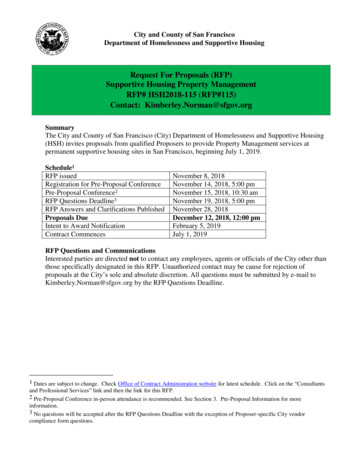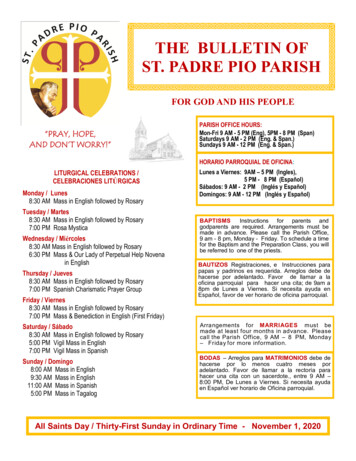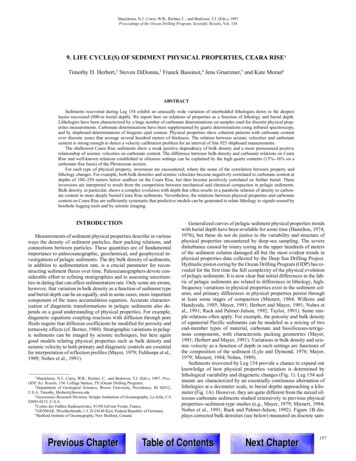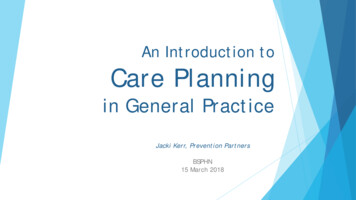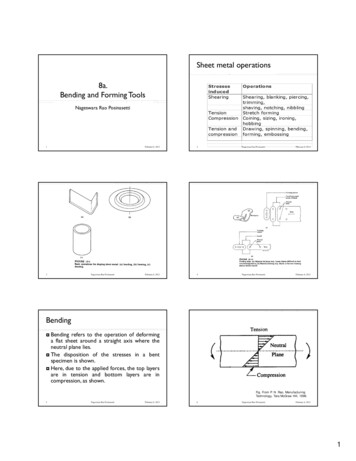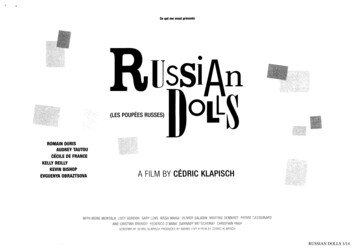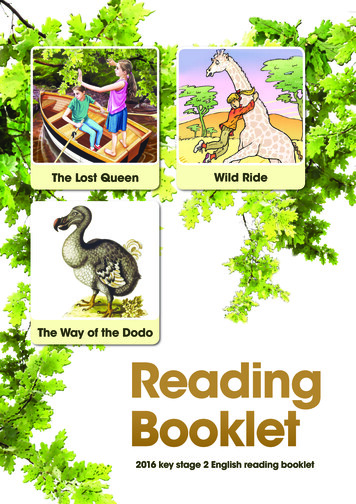
Transcription
MARTINEFRANCKNOVEMBERFEBRUARY2019PRESS KITNEW ADDRESS79 RUE DES ARCHIVES 750 03 PARIS2018
CONTENTSDOUBLE THE EMOTION3OPENING EXHIBITION MARTINE FRANCKINTRODUCTION 6EXTRACTS FROM THE BOOK 7BIOGRAPHY 9BOOK 1179 RUE DES ARCHIVES, NEW ADDRESS OF THE FONDATION HCBCONVERSION OF 79 RUE DES ARCHIVES BY NOVO 12DEVELOPMENT OF ACTIVITIES 13PEARLS FROM THE ARCHIVES 14THE TEAM 15NEW VISUAL IDENTITY CREATED BY ATALANTE 162003-2018 THE FONDATION HCB IN MONTPARNASSEPRESS IMAGES1718OPEN TO THE PUBLIC ON 6 NOVEMBER 2018PRESS VISIT 5 NOVEMBER 201879 rue des Archives – 75003 Paris01 56 80 27 00henricartierbresson.orgPRESS CONTACTThomas LozinskiClaudine Colin Communicationthomas@claudinecolin.com3 rue de Turbigo – 75001 paris01 42 72 60 01NEW OPENING HOURSTuesday to Sunday: 11 am to 7 pmADMISSIONFull rate 9 / Concessions 5Translation into English provided throughthe partial patronage of Agence THOMAS-HERMESwith style, Paris.FOLLOW US ON SOCIAL MEDIAFONDATION – PRESS KIT – MARTINE FRANCK NOVEMBER 2018 / FEBRUARY 20192 / 20
DOUBLE THE EMOTIONDOUBLE THE EMOTION, WITH TWO NEWPHOTOGRAPHIC EVENTS— Martine Franck, Fondation Henri Cartier-Bresson’sfirst exhibition at 79 rue des Archives.— Fondation Henri Cartier-Bresson opens its newpremises in le Marais, Paris on 6 November 2018.MARTINE FRANCKAt the initiative of Fondation HCB, Martine Franck’sphotographic work is finally being given acomprehensive view at an exhibition curated by AgnèsSire, co-founder and artistic director of the Fondation.It has been co-produced with the Musée de l’Elyséein Lausanne where it will be shown in Spring 2019before spending the summer at FOMU in Antwerp.A comprehensive monograph will be publishedby Éditions Xavier Barral.FONDATION HCB, 79 RUE DES ARCHIVESA new venue for photography, after fifteen years atthe forefront since it opened in Montparnasse in 2003.With a more flexible, street-level exhibition space thathas been more than doubled in area – soon to betripled –, the new premises offer greatly improvedfacilities for receiving the public, school visits andpersons with reduced mobility as well as conservationconditions meeting the highest standards andcollections gathered on one single site offering moreconvenient access for researchers. The space designedby the Novo architectural agency establishes theFondation Henri Cartier-Bresson in the cultural heartof le Marais, an outstanding area in Europe, enablingthe Fondation to expand the scope of its endeavoursfor a growing audience.OPENING PROGRAMMEThe first four exhibitions are all events that reflect thediversity so important to the Fondation which has alwaysmade a point of presenting talented artists:— 6 November 2018 / 10 February 2019Martine Franck – A retrospective. A journey throughthe life of a free spirit (Belgian 1938-2012), fromactivist gatherings to meditative landscapes, politicalengagement to friendly portraits, this deeply humanvision open to the history of art was associatedwith the Viva agency, which she helped create,then with the cooperative Magnum Photos.— 21 February / 2 June 2019Guy Tillim – Museum of the Revolution. A talentedSouth-African photographer born in 1962, he wasawarded the Prix HCB 2017 (supported by theFondation d’entreprise Hermès) for this project. Theexhibition will reveal the ambitious result achievedover several years, in African capital cities, questioningthe paradoxes and contradictions of colonial and postcolonial years. Guy Tillim develops his firmly artisticapproach by playing with the juxtaposition of prints.Henri Cartier-Bresson – La France (Part 1). Never sincethe end of the 50s has Henri Cartier-Bresson’s workon France (1908-2004) been explored. This exhibitionwill feature a first selection.— 13 June / 25 August 2019Wright Morris (1910-1998), American writer andphotographer and author of the famous book TheInhabitants, will be the guest of our new exhibitionspace. His unique dual practice was highly influentialin the United States in the second half of the twentiethcentury. For the first time in France, the Fondationis presenting his dual photographic and literary visionof the American heartland, showcasing the uniquewriting of a brilliant unrecognised author.Henri Cartier-Bresson – La France (Part 2).— 4 September / 17 November 2019China by Henri Cartier-Bresson. After the bookD’une Chine à l’autre (1954), with an introductionby Jean-Paul Sartre, the work done by Henri CartierBresson in China has never been seriously lookedat again. The Fondation has now worked with thehistorian Michel Frizot who will offer a detailed studythanks to the many documents kept in the archivesand will curate the exhibition and create the book.The exhibition will subsequently be shown in China.Martine Franck – Landscapes. “I’ve alwaysphotographed landscapes, for pleasure, out of need.These photographs are the opposite of snapshots.”Martine FranckFONDATION – PRESS KIT – MARTINE FRANCK NOVEMBER 2018 / FEBRUARY 20193 / 20
DOUBLE THE EMOTIONEVENTSFor each exhibition, there will be a rich programmeof events and talks at 79 rue des Archives which will beannounced in January 2019. The aim of this new venueis to become a forum for exchange and education whereknowledge about photography can be shared witha variety of audiences.PEARLS FROM THE ARCHIVESIncreasingly curious about the man who was HenriCartier-Bresson and his work, our visitors’ experiencewill be punctuated by a series of “Pearls”, the fruit ofresearch into the Fondation’s archives. The work will beresituated, in a new editorial approach, as the work ofa young man steeped in art and literature, espousinghis time as well as the diversity of society and the world,with immense curiosity, humour and talent.DISTRIBUTION OF WORKSBeyond its own site, the Fondation will continue tosupport the works of Henri Cartier-Bresson and MartineFranck being shown in many institutions around theworld and promote the work of researchers by givingthem the best access to archives. The Magnum Photosagency, created by Henri Cartier-Bresson, at theinstigation of Robert Capa, along with George Rodgerand David Seymour, continues to handle requests forcopyright syndication.With Kristen van Riel, chair of the Fondation, whooversaw the move to these new premises, Agnès Sirewho has so successfully established FHCB’s firmposition in the global photographic landscape, theboard of directors and the various public and privatepartnerships who helped us prepare this ambitiousproject, and our extended team, we’re looking forwardto welcoming a wider audience with many new offeringsat 79 rue des Archives.This is a project that Martine Franck had wished for andsupported before her untimely death in August 2012.François Hébel, Director,Paris, 22 June 2018FONDATION – PRESS KIT – MARTINE FRANCK NOVEMBER 2018 / FEBRUARY 20194 / 20
INAUGURAL EXHIBITIONMARTINE FRANCK6 NOVEMBER 201810 FEBRUARY 2019INTRODUCTIONFor the opening of its new spaces, the Fondation HCBwanted to pay tribute to Martine Franck by aretrospective dedicated to her. Martine Franckprofessed a wonder and celebration of life, a profoundjoy faced with humanity while at the same time fightingagainst exclusion with all the empathy she was able toshow. A socially engaged photographer, Martine Franckbecame an activist for many of these causes sheactively photographed, which required a great deal ofcourage and daring for the young woman who had beentaught not to cross the boundaries. “A photograph isn’tnecessarily a lie”, she said. “But nor is it the truth. [ ]You have to be ready to welcome the unexpected”.Born in Antwerp in 1938, Martine Franck grew upin the UK and the United States as part of a familyof collectors. A polyglot, history of art student andpassionate about sculpture, it was during a long tripto the Orient in 1963 that she discovered photography.On her return to Paris, she worked for Time-Life andbecame the assistant of Gjon Mili and Eliot Elisofonbefore becoming an independent photographer.Collaborating with the major American magazines,her reportages and portraits of artists and writers havebeen published in Life, Fortune, Sports Illustrated, TheNew York Times and Vogue. Quickly giving up fashionphotography, she was involved in the adventure of theThéâtre du Soleil troupe from the start, with her friendAriane Mnouchkine, and helped set up the Vu agency,then Viva. In 1970, she married Henri Cartier-Bresson,an accomplished artist, who encouraged her to followher own way. She later joined the Magnum cooperative,which still handles her work today.In addition to her accomplished life as a photographer,the creation of the Fondation Henri Cartier-Bresson in2003 was a high point. Very conscious of the enormouslegacy that would be left to the family if nothing wasdone, Martine Franck enthusiastically embarked on thecreation of a public foundation to house and share bothher husband’s and her work. She explains that this wasthe moment she finally felt proud of the means shehad been left by her family. For her, this foundation builtwith Henri Cartier-Bresson and their daughter Mélanierepresented a final step towards freedom: freedom tocreate, preserve and collect. She had finally crossed theline, and gently implemented this transgression whichcontinued the family tradition of sharing art.Martine Franck photographed by Henri Cartier-Bresson,Venice, Italy, 1972The work on the exhibition and accompanying bookwas begun a long time in advance, in 2011, by AgnèsSire with Martine Franck, when she knew she was ill.The photographer wanted to entrust the creationof the book and the curating of the exhibition to theperson with whom she’d been managing this Fondationfor many years. The selection of photographs, the morechronological sequence, punctuated with texts, andthe interview with her friend, the writer Dominique Eddé,were the main features of this vast project. In it, you canfollow the thread of her engagement through series ofportraits, quasi-abstract landscapes, which are boundto surprise, and a sort of remote chronical of politicallife. Consisting of photographic prints, books anddocuments taken from the Fondation’s fund, theexhibition has been organised in collaboration withthe Musée de l’Élysée in Lausanne and the FotoMuseumin Antwerp which will present the exhibition in 2019.EXHIBITION CURATORThe exhibition has been curated by Agnès Sire, artisticdirector of the Fondation Henri Cartier-Bresson.COLLABORATION AND PARTNERSThe exhibition has been organised in partnership withthe Musée de l’Elysée in Lausanne and the FotoMuseumin Antwerp. It will be shown in Lausanne between20 February and 5 May 2019 and in Antwerp between28 June and 6 October 2019.FONDATION – PRESS KIT – MARTINE FRANCK NOVEMBER 2018 / FEBRUARY 20195 / 20
“ It’s a drop in the ocean, but I believe in it.To be a photographer, you need a good eye, a senseof composition, compassion and a sense ofengagement.” MARTINE FRANCK“ The camera is a frontier in itself; you can only get tothe other side by forgetting yourself, momentarily.” M.F.“ What strikes me in photography is that there’sa desire to understand, to understand oneself.It’s a never-ending quest in life.” M.F.“ I feel concerned by what’s happening in the worldand involved in what surrounds me. I don’t want to just“document”, I want to know why something bothers meor appeals to me and how a situation can affecta person. I’m not trying to create a situation and neverwork in a studio; I’m trying more to understand,to grasp reality. I’ve found in photography a languagethat suits me.” M.F.FONDATION – PRESS KIT – MARTINE FRANCK NOVEMBER 2018 / FEBRUARY 20196 / 20
EXTRACTS FROM THE BOOKMARTINE FRANCKPUBLISHED BYÉDITIONS XAVIER BARRALFONDATION HCBEXTRACTS FROM DOMINIQUE EDDÉ’S INTERVIEWWITH MARTINE FRANCKEXTRACTS FROM THE TEXT BY DOMINIQUE EDDÉ“AUSTERITY AND GRACE”Dominique Eddé: What’s your strongest motivation asa photographer?Martine Franck : My empathy. I want people to feel it.I love people. I’m not very critical. Life is so complicatedand I love it when someone achieves something insomething. I’ve always been very attracted by peoplewho have a passion for what they do. And I’ve alwaysbeen interested in the cause of women. I’ve done a lot ofphotography of feminist movements, all the attemptsthat led to the liberation of women’s rights, all over theworld. I’ve also focused on their quest to establish theirrights, on contraception and abortion, but also younggirls in difficulty on the fringes of society. And of course,age. I’ve always been tender with what age teaches me.It’s very important in my work. I don’t really try to tellstories, I try to suggest situations and people. For me,photography isn’t just a job. I’ve received so much in mylife, I wanted to give something back by sharing whatand those whom I love.Martine Franck as a person and her work are verysimilar; both inhabited by the same humanity, the samesimplicity, the same self-respect and respect for others.It’s a shame there isn’t a word for the exact opposite ofvulgarity. Neither distinction nor refinement completelyexpresses the way she has of combining dignity withkindness or a the taste for life with taste pure andsimple. When she tells us that Henri Cartier-Bressondidn’t like excess, but its opposite – structure andequilibrium –, you obviously think about their connection:the beauty of the equilibrium he found in her.Do you sense a good photo right away?Yes, you really feel it when you’re doing your best. Thereare few surprises after the shot. Bad surprises, yes butgood ones? Practically never.It’s not by chance that Martine Franck was naturallydrawn to portraits and landscapes rather than placesof poverty and conflict. In her vision of the world, there’sa constant need for openness and horizon; a contagiousindulgence that’s invariably reflected on the faces shephotographs. People are confident in her presence.They seem delivered from the duty to pose. They’re likeher: inside and out. So much so that “the decisivemoment” is rarely implacable in her images.FONDATION – PRESS KIT – MARTINE FRANCK NOVEMBER 2018 / FEBRUARY 20197 / 20
EXTRACTS FROM THE BOOKMARTINE FRANCKEXTRACTS FROM THE TEXT BY ANNE LACOSTE“TAMING TIME”Although Martine Franck sometimes chose to developindividually commissioned subjects further, she mostlyspent time on themes related to her favourite subjects.Rather than a systematic study within a specifictimeframe, the photographer chose to approach thesesubjects in an ad hoc way, over a long period. So sheenjoyed a certain latitude in developing these themesaccording to the events she participated in, driven byher own interest or for commissioned works.When she decided to take up a career as aphotographer, Martine Franck chose a sphere of activitywhere there were still few women, including SarahMoon, Sabine Weiss, Janine Niépce and Cathy Leroy.She embodied this minority at the Magnum agency withEve Arnold, Susan Meiselas, Inge Morath and MarilynSilverstone, amongst others. The existence of aspecifically feminine vision and photographic approachwas also a recurrent question in her interviews.Although Martine Franck answered this question bytalking more readily about individuality than gender, thefeminine condition is nonetheless an important subjectin her photographic work. The period was in fact markedby a fundamental questioning of women’s status insociety which upturned the patriarchal system from the1960s, with in particular divorce reform and the Veil Lawenshrining the decriminalisation of abortion in 1975.She photographed many demonstrations, particularlythose of the French Women’s Liberation Movement inthe 70s and 80s and worked on the first issue of themovement’s journal, Le torchon brûle, published in May1971. Her trips abroad were also an opportunity todevelop the subject, including the feministdemonstrations in New York in 1974, the “Women WalkHome” in Cyprus in 1975 or Women’s Dayin Beijing in 1980.condition such as the 1969 and 1970 Vogue series“Les Contemporaines”, dedicated to women selected fortheir confirmed life choice. In 1982, she made portraitsof the photographer Sarah Moon, the composer BetsyJolas, the blues singer Colette Magny, the writer ChantalChawaf, her friend Ariane Mnouchkine and the directorAgnès Varda for a commission by the Maison de laCulture du Havre and the French Ministry of Women’sRights entitled “Des femmes et la création”. In 1991,for the proposed exhibition “Des métiers et desfemmes” commissioned by the French Minister forWomen’s Rights, she photographed women who hadchosen a «male» job like she had: fisherwoman, trainconductor, mountain guide, electrician at Aérospatialede Toulouse. She also produced photo reports on thefeminine condition, such as those she dedicated towomen in detention (1987) or welfare missions such asthe Le Moulin Vert charity for mothers and their children(1992) or the community for victims of violence in SanDiego, California (for the Marie Claire magazine, 2002).She participated in several group projects such as thedelegation of the International Commission for Women’sRights who went to Teheran on a fact-finding mission in1979 or the Reporters Without Borders project, “Elleschangent l’Inde” [The women who change India] in thestate of Gujarat, in Ahmedabad, in 2010. This theme wasmaterialised the same year by the publication ofWomen/Femmes, which included a selection of herphotographs on the subject.Martine Franck focused on this issue on a daily basis.During her documentary reportage on life in theSaint-Pierre-de-Chaillot district in Paris in 1973,she particularly felt how “menial” the women’s work wasand resolved to photograph cleaners, bank employees,models and strip-tease artists to document this.Her shots of posters in the public space or magazinecovers highlighted the iconography of the woman as anobject and how inappropriate this was in the publicarena. Her portraits of women at their workplace inRomania, in 1975, showed the same interest. The factthat she was a female photographer also gave herprivileged access to subjects concerning the feminineFONDATION – PRESS KIT – MARTINE FRANCK NOVEMBER 2018 / FEBRUARY 20198 / 20
BIOGRAPHY1938Martine Franck was born on 2 April in Antwerp, Belgium.She grew up in the United States and studied in LongIsland and Arizona, before leaving for Great Britainwhere her father joined the army.1956Began studying history of art at the University of Madrid.1958Admitted to the École du Louvre. Defending her thesison “Sculpture and Cubism: 1907 – 1915”, she met ArianeMnouchkine, who became a prominent figure inFrench theatre.1963Started to photograph the splendours and delightsof China, Japan, India, Cambodia, Nepal, Pakistan,Afghanistan and Iran during an initiatory trip to theFar East with Ariane Mnouchkine. “Photography cameinto my life by chance. I got a visa for China and mycousin lent me his Leica, telling me I was really lucky andI had to bring back some pictures.” She told RolandQuilici in 2007.1964Back in France, worked in Paris for Time-Life whereshe became an assistant to Eliot Elisofon and Gjon Milibefore becoming a freelance photographer. Working forthe major American magazines, her reportages andportraits of artists and writers are published in Life,Fortune, Sports Illustrated, The New York Times andVogue. Formed friendships with Pierre Alechinsky,Balthus, Pierre Boulez, Marc Chagall, Michel Foucault,Michel Leiris, Sam Szafran and Paul Strand. At the sametime, she became a founding member of the Théâtredu Soleil then the official photographer of ArianeMnouchkine’s troupe, a position she never gave up,recording performances, sets and everyday life atLa Cartoucherie.1966Met Henri Cartier-Bresson, thirty years her senior.1970Married Henri Cartier-Bresson. Joined the Vu agencycreated by Pierre de Fenoÿl. Created and producedthe documentary What Has Happened to the AmericanIndians (1970, 17 min).1972Co-founded the Viva agency along with Hervé Gloaguen,Guy Le Querrec, François Hers, Jean Lattes and RichardKalvar. Directed Music at Aspen (Viva Films, 1972, 17 min).1976Martine Franck published by Éditions Contrejour.1977Quartier Beaubourg exhibition at the Centre GeorgesPompidou, Paris.1978Martine Franck. Les Lubérons published by Éditionsdu Chêne.1980Joined the Magnum Photos photography cooperative.Created many reportages supporting humanitariancauses and worked with the International Federationof Little Brothers of the Poor. Published Le Temps deVieillir, in which she wrote: “Not everything can bephotographed. There are moments when suffering andhuman deprivation grip you and stop you. Othersociologically interesting subjects say nothing visually.Photography shows more than it demonstrates,it doesn’t explain the why of things”.Many exhibitions in the 80s, in the UK, Japan,Switzerland, Germany, United Stated, Netherlands, Italybut also France, such as Le Temps de Vieillir at theMusée Nicéphore Niepce in Chalon sur Saône in 1981.1983Previously an associate of the Magnum agency, shebecame a full member. Continued her work dedicatedto the cause of women and feminism.1986La BPI en toute liberté published by Éditions du CentrePompidou/BPI.1992Retrospective dedicated to her at the Museo d’ArteContemporaneo in Santiago, Chile.1993Went to Tory Island in North-West Ireland several timesuntil 1997, where she photographed the everyday life ofa traditional Gaelic community living on the edge of thecontinent.FONDATION – PRESS KIT – MARTINE FRANCK NOVEMBER 2018 / FEBRUARY 20199 / 20
BIOGRAPHY1995Publication of Collège de France. Figures et travaux,Imprimerie Nationale / Paris Audiovisuel, Paris, andJean Giono. The Man who planted trees, Limited EditionsClub. Produced a 26-minute film entitled Ariane etCompagnie with Robert Delpire.1996Travelled to Asia where she photographed the Tulkus,child Tibetan monks living in Bodnath, Nepal and inNorthern India. Produced Tory Island No Treasure Island(Little Brothers of the Poor, 1996, 4 min).1998Exhibition of the projects D’un jour, l’autre at the MaisonEuropéenne de la Photographie in Paris and Tory, île auxconfins de l’Europe [Tory, Island on the Edge of Europe],at the Photographers Gallery in Dublin, published byBenteli Publishing in Bern. Publication of Henri CartierBresson photographié par Martine Franck by ÉditionsFranco Sciardelli Milan/FNAC Paris.2000Collaborated in the production of a documentary filmentitled Retour en Irlande avec Martine Franck,photographe [Return to Ireland with Martine Franck,photographer], produced by Fabienne Strouvé-Beckers.Publication of the book Martine Franck, photographies,by Éditions Claude Bernard with a text by ArianeMnouchkine. Exhibition Tory, île aux confins de l’Europe[Tory, Island on the Edge of Europe] at the Fait et CauseGallery in Paris. Exhibition and publication of TibetanTulkus: Images of Continuity with the Rossi & RossiGallery in London. Exhibitions in different institutions inFrance, the United States and United Kingdom includingthe Howard Greenberg Gallery in New York and theClaude Bernard Gallery in Paris.2002Exhibited at the Musée de la Vie Romantique andcreated the Fondation Henri Cartier-Bresson in Paris,with Henri Cartier-Bresson and their daughter Mélanie.Became the chairman in 2004.2005Martine Franck, Fotografa exhibition at the BBKFoundation in Bilbao and Tibetan Tulkus: Images ofContinuity at the International Festival of Rome.2006Awarded Knight of the Legion of Honour [Chevalierde la Légion d’Honneur].2007Publication of an issue of the Photopoche collectiondedicated to her by Éditions Actes Sud, with a text byAnnick Cojean. The same year Martine Franck ispublished by Éditions Phaïdon, with a text byLouise Baring.2008Martine Franck exhibition at the Kahitsukan KyotoMuseum of Contemporary Art in Kyoto and anaccompanying publication Humanistic Eyes: MartineFranck.2010The Chanel Nexus Hall in Tokyo presents the Femmesexhibition and Women, Femmes is published by ÉditionsSteidl/Chanel.2011In October 2011, the Venus d’ailleurs présente exhibitionis shown at the Maison Européenne de la Photographiein Paris, a series of 62 portraits of artists captured intheir Paris studios between 1965 and 2010 (MichelBarcelo, Marc Chagall, Fernando Botero, Léonor Fini,Ousmane Sow, Zao Wou Ki ). Promotion to the rank ofOfficer of the National Order of Merit [Officier de l’OrdreNational du Mérite] and Winner of the Prix Montblancde la Culture for her work at the Fondation HCB.2012Exhibition of a hundred or so portraits of artists at theClaude Bernard Gallery and Pérégrinations presented atthe Howard Greenberg Gallery in New York.Died on 16 August 2012 in Paris.2003Documented the work of Robert Wilson, stage directorat the Comédie Française, and photographed hisstaging of La Fontaine’s fables in particular. This led tothe publication of Fables, by Éditions Actes Sud. MartineFranck, photographe published by Éditions des Muséesde la Ville de Paris/Éditions Adam Biro.FONDATION – PRESS KIT – MARTINE FRANCK NOVEMBER 2018 / FEBRUARY 201910 / 20
BOOKMARTINE FRANCKÉDITIONS XAVIER BARRALFONDATION HCBBound23 x 29.2 cm300 photographs and documents238 pagesForeword by Agnès SireTexts by Anne Lacoste and Dominique EddéInterview with Martine FranckBiography produced by Cécile Gaillard with Aude Raimbault60 ISBN 978-2-36511-125-6FONDATION – PRESS KIT – MARTINE FRANCK NOVEMBER 2018 / FEBRUARY 201911 / 20
CONVERSION OF79 RUE DES ARCHIVESBY NOVOThe interior design of the Fondation Henri CartierBresson was created by the NOVO firm of architects(Henri Barthélémy, Alain Cieutat, Simon Barthélémy andIliana Genova). Considering the needs foraccommodating a wide range of audiences, conservingarchives and allowing access to researchers, the spacewas designed in a spirit of transparency andcommunication; it’s light without being ostentatious.The premises of the Fondation Henri Cartier-Bressonare part of a separate building in a second courtyard inle Marais. This old car park co-owned with the FondationFrançois Sommer, which has its offices on the 2nd, 3rdand 4th floors, has been completely transformed by thearchitects Lobjois Bouvier et Associés, the works beingcarried out by Demathieu et Bard.The materials used are divided into large blocks – whitelacquered metal for the furniture, satin-finish aluminiumon the walls, black polished concrete for the floor –to structure and unify the ground floor into a longcontinuous space open to the public: from the Windowonto the street to the Reception area in the firstcourtyard and through to the building’s Conference andExhibition Rooms past the second courtyard. This hascreated a cohesive space out of what were originallyheterogeneous areas. In the exhibition spaces,obstructions have been reduced to a minimum so thatbig mobile gallery walls can be used to adapt the spaceand create a wide variety of display areas. On the firstfloor, particular attention has been paid to the concernsof preservation and access to Archives given the qualityof the Fondation’s heritage. A library is available forresearchers and meetings. Wood enhances the intimatenature of this floor and the overall feel reflects thedesire to serve the needs of the artworks and visitorsalike, in an implicitly elegant architectural style.The new premises of the Fondation HCB receivedthe support of:— the French Ministry of Culture— the Île-de-France Region— the Mairie de ParisAs well as the support of Martine Franck’s familyfor the creation of the Library.FONDATION – PRESS KIT – MARTINE FRANCK NOVEMBER 2018 / FEBRUARY 201912 / 20
DEVELOPMENTOF THE FONDATION’SACTIVITIESEXHIBITIONSWhen it opens, the Fondation will have doubled its linearspace used for temporary exhibitions and the displayof a large selection of the permanent collection. In asecond phase, a new room will be opened, tripling theexhibition space compared to the Montparnasse site.EDUCATIONThe new building includes a room made available toassociations, schools and the young public. The openingof these new spaces will be accompanied by a series ofprogrammes educating different generations about theexhibitions and encouraging them to decode theimages.COLLECTION— The foundation’s artistic heritage will be broughttogether and preserved in the new space, accordingto the latest conservation standards.— nearly 50,000 original prints— more than 200,000 negatives and contact sheets— more than 1,500 books— 4,500 letters and manuscripts— more than 6,000 press articles, publications anddocuments.WINDOWThe window onto rue des Archives already shown inan early 20th century photograph by Eugène Atget willdisplay a series of new installations reflecting theactivities of the Fondation.RESEARCH AND INTERNATIONAL DISTRIBUTIONA research room will be made available to researchersand curators to facilitate their work and promote theinternational presence of the works of the collection.EVENTSDuring On the occasion of exhibitions, the Fondationwill organise a rich programme of events opening thedoor to different disciplines and innovative formats,from January 2019.BUDGETThe Fondation is completely private and independentand completed this new project with its own funds andthanks to exceptional investment subsidies from theFrench Ministry of Culture, the Île-de-France region andthe Mairie de Paris. The Franck family supported thebeautiful research library. Various public grants helpedwith the destruction of part of the former car park whichwas required by the architects of Bâtiments de France,to recreate a delightful 18th century courtyard.The annual operating budget for the Fondation in itsnew premises in the le Marais will be approximatelyone million Euros.BOOKSHOPThe bookshop specialising in photography will havemore than 600 books for sale, including many referencebooks on Henri Cartier-Bresson and Martine Franck.The selection will also include monographs, scientificand collective books, exhibition catalogues, essays andoriginal or self-published publications, related totemporary exhibitio
Nov 06, 2018 · 01 42 72 60 01 Translation into English provided through the partial patronage of Agence THOMAS-HERMES with style, Paris. FONDATION – PRESS KIT – MARTINE FRANCK NOVEMBER 2018 FEBRUARY 2019 3 / 20 . life. Consisting of photographic prints, books and documents taken from the F
